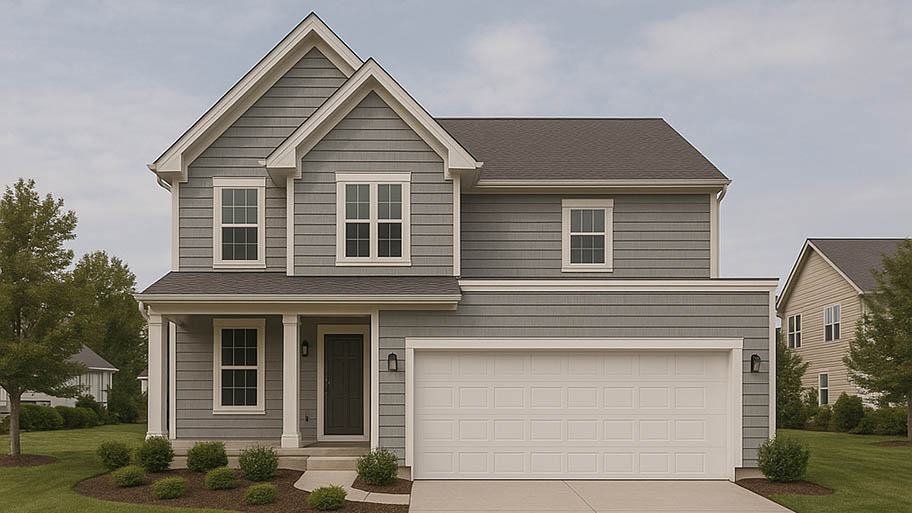
The type of material used and the size of the project will determine metal siding cost. Use this guide to explore all of the factors that affect the cost.
This hazardous siding material can cause issues for homeowners


Asbestos siding is not eligible for homeowners insurance coverage in cases of removal, replacement, and repair.
Some homeowners insurance companies may cover asbestos siding remediation if it’s necessary due to a covered loss.
Common signs of home asbestos siding include wood grain patterns and texture, nail holes, or a missing manufacturer code.
Have you discovered that your home has asbestos siding, or does the house you are considering buying have it? Either way, you may be concerned and wondering, “Is asbestos siding ineligible for coverage?” This siding material causes tricky situations for homeowners, especially when it comes to homeowners insurance policies.
Let’s dive into what asbestos is exactly, common characteristics to help identify it, and whether it’s ineligible for coverage.
Unfortunately, many homeowners insurance companies will not include coverage for asbestos siding because of the potential health risks and cost of removing it. Homeowners insurance companies exclude coverage for asbestos siding removal, replacement, or repair due to its categorization as a pollutant.
However, in some cases, there may be coverage for removing it if the damage was caused by a natural disaster or other incident that’s covered by insurance. For example, if part of your home was destroyed by a natural disaster, such as a hurricane or tornado, your plan may cover the replacement cost. But getting coverage for asbestos siding itself is excluded from homeowners insurance policies in most cases.
It may shock you to learn that asbestos is a natural mineral fiber found in soil and rock. Due to its heat resistance and durability, asbestos was commonly used in construction applications and in materials for buildings and homes to protect them from severe weather, fire, and other damages. Asbestos is found in materials such as shingles, insulation, flooring, and siding.
However, because it contains carcinogens, the Environmental Protection Agency partially banned products containing asbestos in the late 1980s. Significant health effects from exposure to asbestos include asbestosis, lung cancer, and mesothelioma. The problem is that the fibers are released into the air when the materials are disturbed or removed. This is why it’s vital to always hire a professional whenever you need to remove products containing asbestos.
The only way to know for sure if a home has asbestos siding is to hire a local asbestos testing company to collect a sample and send it to a lab. However, there are some common characteristics you can look for to clue you in on if it’s possible your siding is made with it.
Remember that the EPA didn’t ban asbestos products until 1989, so homes that were built before then are more likely to have it.
Here are some identifying traits of asbestos siding:
Wood grain patterns and texture: If your home has wood grain siding, there is a chance it can contain asbestos. It will look like it has a chalky texture, and as it deteriorates, it will look rough around the edges.
Nail holes and visible fibers: Check for nail holes at the bottom of each shingle and inspect to see if your siding is made with fibrous material, as that is a common clue that it may be asbestos.
Missing manufacturer code: Some siding may be missing the manufacturer code, which isn’t good. If you see a manufacturer code, it means that it is newer siding and is more likely not to contain asbestos. But again, the only way to know for certain is to have it tested.
Whether you should replace your asbestos siding depends on its condition. Since asbestos is dangerous when disturbed, you should always hire an asbestos removal company near you to tackle the task.
The total cost of removing asbestos siding depends on several factors, such as the type of siding, job size, and your location. The average cost ranges between $700 to $5,700, but can reach as high as $16,350.
But you don’t want to expose yourself to the potentially dangerous health risks associated with inhaling the fibers from this material. So, if you suspect your home may have asbestos siding, make sure to call a professional to test it and consult them on the best way to repair or remove it.
From average costs to expert advice, get all the answers you need to get your job done.

The type of material used and the size of the project will determine metal siding cost. Use this guide to explore all of the factors that affect the cost.

New fiber cement siding improves curb appeal and your home’s value, while also boosting energy efficiency. Learn about fiber cement siding installation costs in San Francisco.

The cost of vinyl siding installation in San Francisco depends on several factors, including the size of your home and the type of vinyl siding you choose. Learn how to budget in this guide.

In this guide, we break down the strengths and weaknesses of the two most popular materials for home exteriors to help you choose the best one for your needs.

From clapboard to shiplap, there are tons of wood siding types for you to choose from. Here’s a run-down of the ten most popular types of wood siding.

When installing siding, you may find rotted boards underneath the old siding. Siding is your home’s first line of defense against the elements–rot causes damage that can spread, so learn about what to do when you discover rotted boards.